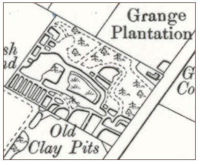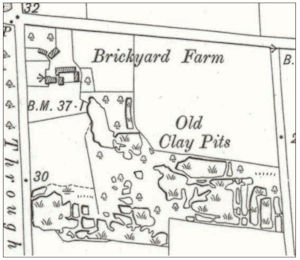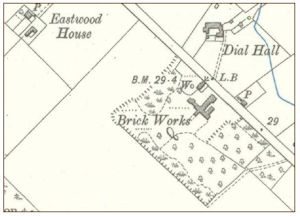|
The Ogle family of Brickmakers
 sm.jpg) |
|
The East Riding branch of the Ogle family who worked ‘Brickyard Farm’ at Melbourne has already been discussed in some detail in the article entitled ‘Brickmaking in Pocklington & the Local Area’ on the Pocklington & District Local History Group website, so repetition will be avoided where possible.
The Ogles were a very large family of predominantly brick and tile makers, originating in the mid-1600s at the complex of brickyards outside Nottingham, plus a small yard at Clarborough near Retford. By the early 1700s, several descendant branches had begun to migrate northwards into South Yorkshire and North Lincolnshire, with others continuing to small brickyards in the North Riding and several large and small
yards in the Gateshead/Newcastle area.
The branch that ended up living near to and working in Melbourne brickyard was headed by Henry Ogle who was born c. 1766 in the North Lincolnshire village of Horkstow, near a brickyard alongside the River Anchome flowing into the Humber near South Ferriby. He subsequently crossed the Humber into the East Riding, married Mary Dawson in Cherry Burton in 1789 and they started a family at Newport near North Cave, presumably with Henry workingat one of the several brickyards alongside the recently-opened Market Weighton Canal.
 The family next moved to a brickyard on Carr Lane at Newton-on-Derwent (now Carr Farm) in the mid-1790s; then in the early 1800s to a similar-sized brickyard (a.k.a. the ‘Old Brickyard’) half a mile south-west of Melbourne village at Grange Plantation, probably owned by the Vavasour family at Melbourne Hall; and finally, by the 1830s, to a more extensive enterprise at ‘Brickyard Farm’, a mile south of the village, and again owned by the Vavasours. The family next moved to a brickyard on Carr Lane at Newton-on-Derwent (now Carr Farm) in the mid-1790s; then in the early 1800s to a similar-sized brickyard (a.k.a. the ‘Old Brickyard’) half a mile south-west of Melbourne village at Grange Plantation, probably owned by the Vavasour family at Melbourne Hall; and finally, by the 1830s, to a more extensive enterprise at ‘Brickyard Farm’, a mile south of the village, and again owned by the Vavasours.
In all, Henry and Mary had 8 children, 2 at Newport and the remainder at Newton, the youngest being Charles Ogle who raised his own family and ran ‘Brickyard
Farm’ after his parents had retired to Melbourne village sometime before the 1841 census.
 The Melbourne brick-maker John Lamb and his family (who John Kent records as having emigrated to Leesville in the USA in 1842) was resident with one other brickmaker at the ‘Old Brickyard’ in the 1841 census, so evidently worked there after Henry Ogle’s retirement. The Melbourne brick-maker John Lamb and his family (who John Kent records as having emigrated to Leesville in the USA in 1842) was resident with one other brickmaker at the ‘Old Brickyard’ in the 1841 census, so evidently worked there after Henry Ogle’s retirement.
Henry & Mary Ogle’s other 5 sons all left Yorkshire for the USA:
- In 1818, bricklayer Atkin Smith Ogle emigrated to Baltimore, Maryland, where he married and had a son, George Atkin Ogle, who came back to the East Riding in 1870 to marry his first cousin Mary Dunkin DesForges in Hull, returning to Baltimore with his bride. Atkin Smith Ogle later became a ‘Measurer of buildings’ in Baltimore.
- On 30th Jun 1830, brickmaker Henry Ogle emigrated to Baltimore, with his family.
- Also on 30th Jun 1830, brickmaker and bricklayer Joseph Ogle emigrated to Baltimore with his family. Subsequently he made and laid the bricks for St. Stephen’s Episcopal Church in Odenton, Maryland, some 10 miles from Baltimore, his son-in-law having donated the land. Joseph also received a patent for a brick kiln.
- George Ogle emigrated to the USA with his family on 23rd Nov 1830, becoming a tavern keeper in Syracuse, New York
- John Ogle also emigrated to the USA on 23rd Nov 1830. (Nothing further is known of John.)
 By the 1870s, one of Charles Ogle’s sons, George Henry Ogle, had moved to East Farm, Melbourne, and took over the ownership of the nearby Seaton Ross brickyard, from where (as reported by John Kent) 3 brickmakers had emigrated to Leesville in the period 1844-57. By the 1870s, one of Charles Ogle’s sons, George Henry Ogle, had moved to East Farm, Melbourne, and took over the ownership of the nearby Seaton Ross brickyard, from where (as reported by John Kent) 3 brickmakers had emigrated to Leesville in the period 1844-57.
Another of Charles’s sons, Thomas Eastwood Ogle, later moved with his widowed mother to Plantation House near the Seaton Ross brick works and which they renamed ‘Eastwood House’ after a Weslyan minister Thomas Eastwood who had married into the family. (Note ‘Dial Hall’, the home of William Watson, opposite the brickyard.)
|

